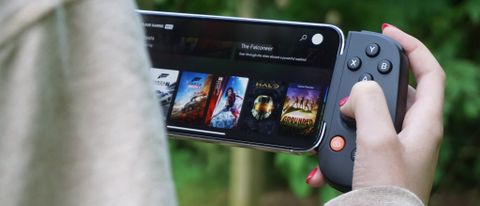The rise of cloud gaming has driven a new era of mobile gaming accessories for smartphones, many imitating dedicated handheld consoles, albeit some more viable than others. The Backbone One is among the latest breaking into the space, and with Microsoft expanding its game-streaming tech to iOS, there's a compelling basis for its $99 asking price to Xbox owners.
I've tried a handful of different mobile controllers in recent months, each designed to bring the comfort and convenience of gamepads to touch screens. But the Backbone One is a different breed of accessory, with calculated considerations for both hardware and software, delivering an experience close to a traditional handheld. This isn't another bolted-on accessory — it acts just like a Nintendo Switch.
I first picked up the Backbone One with the Xbox Cloud Gaming platform in mind, and after one week, it's unquestionably the best out there for iPhone. It navigates Apple's notoriously strict grip on iOS with a portfolio of tightly integrated features via its accompanying app. It has high ambitions, vying to deliver a top-tier controller, plus a full-fledged gaming platform for iPhone.
Here's what's stuck after one week with the Backbone One controller, and what to expect, should you pick one up for mobile gaming.
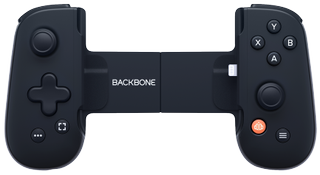
Bottom line: Backbone has delivered the best controller for iPhone, fusing stellar hardware with cleverly integrated software. It shines when paired alongside Xbox Cloud Gaming, bringing a full console-like experience to mobile, mirroring handhelds like the Nintendo Switch.
For
- Familiar, comfortable controls
- Great build quality and fit across different phones
- Strong software support
- Overall polish unmatched by alternatives
Against
- Poor support for cases and other accessories
- iPhone 13 Pro models require separate adapter
Backbone One: Price and availability
The Backbone One controller is available for $99 in the U.S. and is compatible with all current iPhone models running iOS 13 or later. The company has also launched the Backbone One controller in the UK and Japan for £99 and ¥12,980, respectively, with free shipping via the official Backbone website. Select retailers also offer international shipping to additional regions.
The controller is available via Amazon US and the Microsoft Store, alongside the official Backbone website. Backbone One purchases also include complimentary Xbox Game Pass Ultimate subscriptions for new subscribers, up to three months. No Android version has been announced at this time.
Backbone One: What you'll like
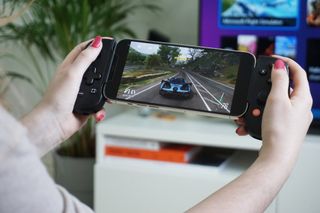
Cloud gaming is steadily becoming a reality, and while several contenders have already tried and failed, Microsoft is among the frontrunners with its Xbox "xCloud" game streaming tech. The seasoned platform holder has expanded its Xbox Game Pass subscription offerings to iOS, with an expanded beta now available to all Ultimate-tier subscribers. But navigating the Apple policies has repeatedly posed challenges, from Microsoft openly slating Cupertino's tight grip on the platform, now sidestepping the App Store for a web-based experience. Xbox Cloud Gaming introduces a new reason to convert to iOS gaming, with gamepads the best way to play console experiences on a touchscreen.
Enter the Backbone One, an iPhone controller which sprung onto my radar in the lead up to the arrival of cloud gaming. The gamepad is the first creation from Backbone Labs, a fresh San Francisco startup, currently working around the shapes and sizes of modern iPhones. It supports countless iOS titles with gamepad integration, and a Microsoft partnership blesses it with the "Designed for Xbox" tagline. There lies the next opportunity for Backbone, with deep integration with Xbox services, it's also the standout solution for cloud gaming on Apple phones.
Backbone One is a different breed of accessory, with calculated hardware and software that tie the experience together.
The Backbone One design will be immediately familiar to many, splitting a controller into two adjacent panels and your iPhone sliding into the center. It's the closest alternative to a Nintendo Switch for mobile phones, emulating the split "Joy-Con" controls with an adjustable rail that scales the device's width for different screen sizes. It supports every modern iPhone with iOS 13 or later, hooking up over a direct Lightning connection, eliminating the added latency introduced by Bluetooth controllers.
The stick and button layout mirrors the Xbox controller, adopting the same ABXY configuration (a pain point when transitioning to Nintendo systems) with offset thumbsticks and commonplace inputs. It's incredibly comfortable for extended use, among the best solutions for ergonomics. The shallow profile makes the bumpers and triggers a little small, although it's an inevitable sacrifice for a slim, portable machine. It's easy to get hooked on games, without thinking twice about controls, all tying back to the streamlined design.
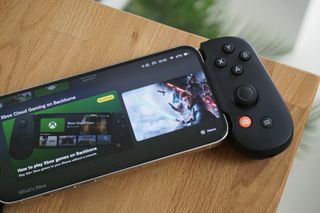
The Backbone One supports any iPhone currently on the market, with its telescopic, spring-loaded design accommodating the full spectrum of Apple hardware from Pro Max to Mini. It has a rubberized plate and tight clasp with ample room for either device but no unwanted flex. We first tested the Backbone One controller at launch with an iPhone 12 Pro Max and base iPhone 11. The slim design means you can't connect the phone with most cases, even with the ultra-thin Apple MagSafe clear case, which adds barely 2mm of thickness.
The iPhone 13 has been released since our initial review, with revised camera dimensions meaning the latest 13 Pro and 13 Pro Max entries don't fit inside the Backbone One. The company has released an adapter as a workaround in the meantime, available for free via the Backbone website. It's also shipping the same adapter with all new Backbone One purchases. It's a smart workaround to a new challenge for the company, but it's far from an elegant solution.
The device is well constructed and ultimately matching the expected quality of official first-party hardware from Sony or Microsoft. The textured plastic materials offer a robust yet lightweight feel, with responsive button clicks and a low-profile silhouette. There's little to fault from the hardware, driving it's best to justify the premium RRP, compared to affordable though less integrated alternatives.
The Backbone One plays well with popular titles, from mobile-first experiences like Call of Duty: Mobile and Minecraft to services like Xbox Cloud Gaming. It joins the extensive lineup of compatible iOS controllers, hugely benefitting mobile gaming's viability, albeit losing the convenience of touch screen inputs.
And for Xbox cloud gaming, my original motivation to try the Backbone One, official support translates full compliance with the platform. It hooks up trouble-free without extra configuration, and its ongoing partnership with Microsoft positions this as a recommended solution for iPhone. You even get three months of Xbox Game Pass Ultimate included alongside the device, although limited to new subscribers.
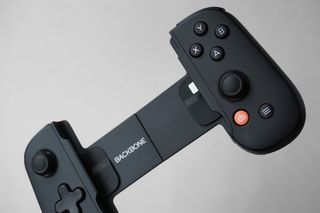
But it's the surrounding experience that elevates the Backbone One, with tight software integration far beyond the capabilities of your standard controller. The device navigates the capabilities and limitations of iOS, delivering an experience that would be hard to replicate across the diverse pool of Android phones. The result mixes a slick app with clever use of system-level features, forming a gaming hub that reflects the modern nature of the scene.
The Backbone One relies on its accompanying companion app, which acts as a barebones pointer to the official store when downloaded from the App Store. You'll need to hook up the controller to unlock the app, opening up the entire home screen-style interface, immediately reminiscent of the current Xbox dashboard. It rounds up your recent games into one menu while also flexing various social features.
Whereas Apple's own Game Center has faded into obscurity in recent years, Backbone brings iOS games into an experience that's likely immediately familiar to console users. It's not a full-fledged platform packed with needless bloatware, but rounds up your games into one easily accessible library, with some social features. You can open to Backbone app at any time with the orange button, essentially acting as the hotkey to your home menu.
Backbone carves out its own friends system, with rich presence to signal when online and active, plus dedicated chat rooms akin to Discord voice channels. There are also handy capture tools built into Backbone One, mapped to a dedicated hardware button on the controller. Holding this button grabs a screenshot, saved directly on-device to your photo library. Tapping the button also surfaces a capture interface, leveraging Apple's own inbuilt screen-recording technology for a direct gameplay feed. The software feels at home for console gaming rather than navigating a standard mobile phone.
The Backbone One will change how you play mobile games, and the app only adds to that broader "experience," rather than just a controller. We've previously recommended devices like the Razer Kishi for iOS, yet stellar ergonomics and build quality see Backbone One emerge on top. The accompanying software experience only helps differentiate this from competitors, easily among the best controllers for Xbox Cloud Gaming.
Backbone One: What's not so good

The Backbone One separates itself from other controllers through a series of triumphs, executing its mobile experience with full considerations for hardware and software. It leaves little to fault for everyday use, but that's not without frustrations I'd hope to see resolved in future iterations of the device.
The most significant complaint surrounds different device types, given the minimal leeway for phone cases and accessories. The slightest modifications to the phone footprint render this device unusable, including the official Apple MagSafe clear case for iPhone 12 Pro Max, which adds barely 2mm to the device thickness. The same goes for screen protectors, with slightly raised glass preventing the controller from optimally gripping the phone. That flaw impacted users on a larger scale with the release of iPhone 13 Pro and Pro Max models, with a free adapter required for a comfortable fit.
And while the price is on the expensive end of the mobile controller market, with many of the best controllers almost half the price, it's still worthwhile for the experience on offer. That price may be steep compared to many other controllers, but with incredible support for iOS devices, it's the only option that truly considers what iPhone gaming truly entails.
Backbone One: Competition

The Backbone One enters an emerging but soon competitive market of console-style accessories for mobile gaming, with the success of the Nintendo Switch intersecting with the rise of cloud gaming. Devices like the Razer Kishi have successfully executed this concept, with a similar split-control layout for iOS and Android devices. The first-generation Razer Kishi for iPhone is now available from $55 at many retailers, presenting a more affordable alternative to the Backbone One. However, with a new "V2" revision of the Kishi now available, Razer has taken cues from Backbone's superior ergonomics to improve the controller design.
Your options are otherwise scarce as an iPhone user, with many of the officially licensed Xbox accessories limited to Android devices following almost two years of extensive testing. Microsoft's iOS roadblocks have impacted the available products from third-party manufacturers, especially for those on a tighter budget. Those looking to save will need to consider one of the best Xbox phone mounting clips, getting any existing Xbox Wireless Controller cloud-ready for as little as $10.
Backbone One: Should you buy it?
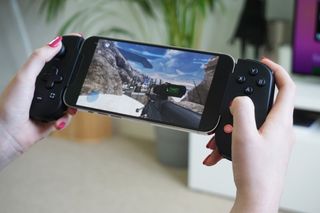
You should buy this if ...
- You have an iPhone.
- You want the best Xbox Cloud Gaming experience.
- You play popular mobile games with controller support like Call of Duty: Mobile and Minecraft.
- You want a controller similar to the official Xbox controller layout.
You shouldn't buy this if ...
- You use an iPhone with large cases, pop sockets, and other hard-to-remove accessories.
- You want to spend less than $100.
- You have an Android device.
The Backbone One is the best gaming controllers out there for iPhone gaming, supporting a vast array of top mobile titles while offering first-class Xbox cloud gaming integration. It's compatible with every modern iPhone out there, maintaining a high standard across all facets of the experience that justifies the $99 asking price. It's the only option that checks all the boxes for the average user, making this the recommended choice for iOS. While we'd hope to see an Android version in the future, Android-compatible devices like the Razer Kishi and GameSir X2 are currently suited to smartphones from Samsung, OnePlus, and more.
Mobile game controllers are now more compelling than ever, with increasingly powerful devices and viable cloud streaming services entering the market. While dedicated handheld devices like the Nintendo Switch are better suited for gaming exclusively, I can't deny the convenience that comes with a $99 accessory. I still find myself playing titles with the Backbone One for extensive periods, which is something I never experienced with other mobile gamepads in the past.
The first product from Backbone isn't perfect, with its strict requirements around cases making the setup more cumbersome than ideal. But the final product, both hardware and software, and nothing short of astounding. That's coming from someone who wasn't on the compromises of a smaller smartphone display, especially for console games. What sold me on Backbone is the same reason I've been migrating to Apple devices in recent months; a consistent user experience that just ultimately feels great to use. Whether for mobile gaming or, for me, finally using cloud gaming regularly, you won't get better than Backbone.

Bottom line: Backbone has delivered the best controller for iPhone, fusing stellar hardware with cleverly integrated software. It shines when paired alongside Xbox Cloud Gaming, bringing a full console-like experience to mobile, mirroring handhelds like the Nintendo Switch.
Matt Brown was formerly a Windows Central's Senior Editor, Xbox & PC, at Future. Following over seven years of professional consumer technology and gaming coverage, he’s focused on the world of Microsoft's gaming efforts. You can follow him on Twitter @mattjbrown.
